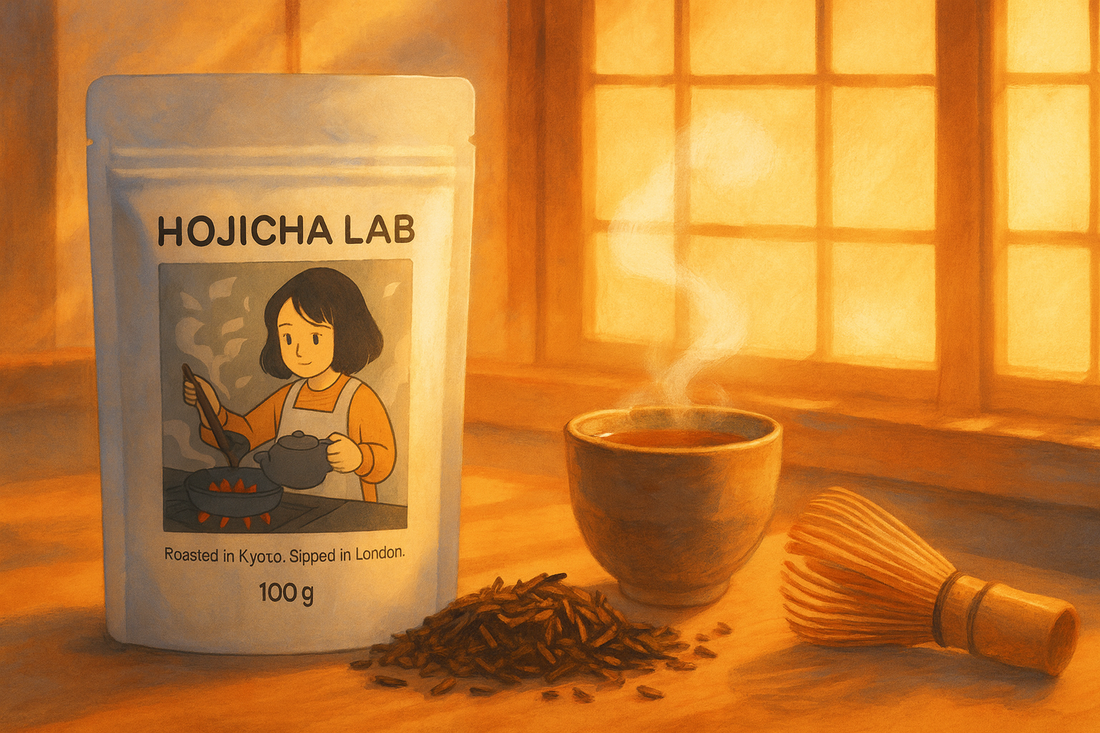
Hojicha vs Matcha: Taste, Caffeine, and When to Drink Each
- Taste: Hojicha is toasty, mellow and caramel-nutty; matcha is fresh, grassy and umami-sweet.
- Caffeine: Hojicha is gentler (often a fraction of matcha per cup), great for evenings; matcha is perkier for daytime.
- Best occasions: Hojicha for cosy wind-downs and calm focus; matcha for bright morning energy and pre-study lifts.
Taste & Aroma (toasty vs grassy)
If you love the cosiness of roasted flavours—think lightly toasted nuts or a whisper of caramel—hojicha is your girl. The leaves are roasted, smoothing away sharp edges and bitterness. The cup tastes mellow, comforting and clean, with an aroma that feels like a soft blanket.
Matcha leans bright and green: creamy umami, a touch of sweetness, and that signature “freshly cut grass” vibe. It’s vibrant on the palate and pairs beautifully with citrus, vanilla and floral notes when you’re in the mood for something lively.
Colour & Roast
Hojicha: Roasting transforms the leaf, giving a copper-to-chestnut hue in the cup. Hojicha powder and lattes look latte-brown rather than green, which feels chic and autumnal year-round. The roast also softens astringency, making hojicha very beginner-friendly.
Matcha: Stone-ground from shade-grown green tea, matcha’s colour ranges from spring-green to deep jade. No roasting here—the goal is to preserve that lush green flavour and the creamy foam you get from whisking.
Caffeine Levels (gentle, evening-friendly)
Exact caffeine varies by leaf grade, preparation and serving size, but as a helpful guide:
- Hojicha (brewed leaves): typically ~7–20 mg per 200–250 ml cup.
- Hojicha powder latte: often ~20–40 mg per serving (depends on powder dose).
- Matcha (1 tsp ≈ 2 g): commonly ~55–75 mg per serving.
That makes hojicha a calm-focus choice for late afternoons or evenings, and matcha a peppier option for mornings or pre-workout. If you’re caffeine-sensitive, start with hojicha—or split your matcha into a half-teaspoon serving.
Latte Texture
Both hojicha and matcha make gorgeous lattes, just with different moods. Whisk either powder with a splash of hot water until smooth, then top with your favourite milk.
- Hojicha latte: naturally silky with a toasted-caramel note. Oat or soy milks amplify the biscuit-like cosiness; dairy gives café-style body with a subtle toffee vibe.
- Matcha latte: creamy, lush and “green-vanilla” when sweetened lightly. The micro-foam looks stunning in photos, and a sprinkle of vanilla or a dash of honey makes it dessert-adjacent.
Best for Mind & Mood (non-medical)
Looking for a clear head without the buzz? Many tea lovers reach for hojicha when they want calm focus—gentle caffeine, grounded flavour, and a ritual that invites slower breathing. It’s a lovely bridge between work mode and wind-down, especially after 4 pm.
When you need a clean lift earlier in the day, matcha brings a brighter energy. Paired with a balanced breakfast, it’s a fab swap for coffee if you prefer a smoother rise.
Lifestyle note: everyone’s different. Tune into how your body feels, and choose the tea that supports your rhythm.
Skin & Wellness (balanced lifestyle)
Both teas sit beautifully in a balanced lifestyle. People love matcha for its vibrant ritual and pairing with movement (Pilates, morning walks), while hojicha shines in cosy routines—journalling, reading, stretching before bed. Hydration, sleep, and a colourful diet will always do the heavy lifting; tea is the gentle, joyful extra that makes the day feel special.
Hojicha vs Matcha: At-a-Glance
| Feature | Hojicha roasted | Matcha green & vibrant |
|---|---|---|
| Taste & aroma | Toasty, caramel-nutty, mellow; low bitterness. | Grassy-fresh, umami-sweet, creamy; more intensity. |
| Roast | Yes — roasted after steaming/drying. | No — shade-grown, stone-ground. |
| Colour | Amber-to-brown brew; latte-brown foam. | Bright jade green; vivid micro-foam. |
| Caffeine (approx.) | ~7–20 mg brewed; ~20–40 mg powder latte. | ~55–75 mg per 2 g serving. |
| Ideal time of day | Late afternoon & evening; calm focus. | Morning & early afternoon; clean lift. |
| Popular drinks | Hojicha latte, iced hojicha, hojicha hot chocolate. | Matcha latte, iced matcha, sparkling matcha lemonade. |
Caffeine amounts are typical ranges; your exact cup may vary with leaf grade, dose and brew time.
Which one is for you?
- Pick Hojicha if you want cosy, low-bitterness flavour and a gentle evening-friendly sip that still supports focus.
- Pick Matcha if you love bright green energy, creamy lattes and a more uplifting taste profile.
- Love both? Matcha in the morning, hojicha after lunch—easy rhythm, zero FOMO.
Discover our smooth, toasty hojicha powder—roasted for flavour, lovely for day or night.
Shop Hojicha Lab PowderFAQ
Can you mix hojicha and matcha?
Absolutely. A 50:50 blend gives a balanced flavour—green freshness plus gentle roast. Start with small amounts and adjust to taste.
Is hojicha decaf?
Not decaf, but naturally lower in caffeine than matcha or coffee. Many people find it suitable later in the day; listen to your body.
Is matcha stronger?
In caffeine and flavour intensity, usually yes. A typical 2 g serving of matcha contains considerably more caffeine than a brewed cup of hojicha.
Which is better for lattes?
Both shine in lattes—matcha for creamy green vibrance, hojicha for toasty, caramel-like comfort. Choose the mood you want.